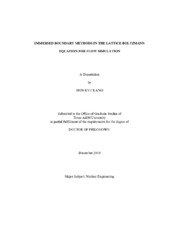| dc.description.abstract | In this dissertation, we explore direct-forcing immersed boundary methods (IBM) under the framework of the lattice Boltzmann method (LBM), which is called the direct-forcing immersed boundary-lattice Boltzmann method (IB-LBM).
First, we derive the direct-forcing formula based on the split-forcing lattice Boltzmann equation, which recovers the Navier-Stokes equation with second-order accuracy and enables us to develop a simple and accurate formula due to its kinetic nature. Then, we assess the various interface schemes under the derived direct-forcing formula. We consider not only diffuse interface schemes but also a sharp interface scheme. All tested schemes show a second-order overall accuracy. In the simulation of stationary complex boundary flows, we can observe that the sharper the interface scheme is, the more accurate the results are.
The interface schemes are also applied to moving boundary problems. The sharp interface scheme shows better accuracy than the diffuse interface schemes but generates spurious oscillation in the boundary forcing terms due to the discontinuous change of nodes for the interpolation. In contrast, the diffuse interface schemes show smooth change in the boundary forcing terms but less accurate results because of discrete delta functions. Hence, the diffuse interface scheme with a corrected radius can be adopted to obtain both accurate and smooth results.
Finally, a direct-forcing immersed boundary method (IBM) for the thermal lattice Boltzmann method (TLBM) is proposed to simulate non-isothermal flows. The direct-forcing IBM formulas for thermal equations are derived based on two TLBM models: a double-population model with a simplified thermal lattice Boltzmann equation (Model 1) and a hybrid model with an advection-diffusion equation of temperature (Model 2). The proposed methods are validated through natural convection problems with stationary and moving boundaries. In terms of accuracy, the results obtained from the IBMs based on both models are comparable and show a good agreement with those from other numerical methods. In contrast, the IBM based on Model 2 is more numerically efficient than the IBM based on Model 1.
Overall, this study serves to establish the feasibility of the direct-forcing IB-LBM as a viable tool for computing various complex and/or moving boundary flow problems. | en |


